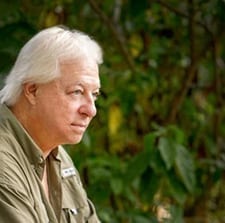The Power Of Moonlit Imagery
September 15, 2022By Tom Poland
Herman Melville created Moby Dick, the great white sperm whale that bit off Ahab’s leg. James Dickey had a 12-point white buck that swam from island to island in moonlight. And I recall boyhood tales of strange white things. There’s something about a wild albino animal that grips the imagination, and if you place it beneath a full moon at midnight, the power of moonlit imagery becomes transformative.
Great Aunt Annie would gather all the children in my mother’s clan around a wood stove on a white frosty winter night and tell ghost stories. Chief among her stories, a favorite of mine, was the mysterious white thing of eastern Georgia’s Broad River Valley. On a Sunday night returning from church, folks would be astride horses and in horse-drawn carriages when the horses would whinny and rear. Silent as white ash settling on a sycamore of white the white thing stepped into the road. The horses bolted.
Aunt Annie told several versions of this tale, so the best I could make of it was that long before dams drowned so many swampland haunts, eastern cougars prowled the land. Albinism does strike and I’ve seen photos of albino porcupines, squirrels, crows, and, of course rabbits, though not the white rabbit of Grace Slick fame. Go ask Alice about that.
All this albinism and full moon imagery came to me when I once again read James Dickey’s essay, “The Starry Place Between The Antlers” in the April 1981 issue of Esquire magazine. Back then Esquire had notable authors write about why they lived where they lived. Dickey lived in Columbia, South Carolina, saddled as it is between the mountains and the coast.
“The sea-deer I cherish above mountain deer, even, because I have never seen them doing what I have been told they do: swimming in moonlight from island to island. I would like to see that …. There would not have to be any reason for them to be swimming; in fact, I had rather there were not any reason. But with the mere possibility the heart of the imagination blazes up like stump-kindling, and starts throwing moonlit shadows, which are antlered. If I maintained that one of these deer, a huge buck with at least twelve points, is said to be dead-white, or moon-white, or breaking-wave white, or angel-white, or black-body-white, I would be accused of making it up, as I just did. But too many hunters and foresters have told me of the swimming deer for me to doubt it. There are deer, they do swim, and at night, and I plan to stay until I see them. Between the deer of the mountains and those of the sea, those down on the salt between the South Carolina islands: that is my balance, and it is right for me: the starry place between the antlers: between the bucks of rhododendron gullies and those of the ocean, the mountain horns and the swimming.”
A white buck swimming in moonlight … It seems to me that if you write about some majestic white creature, you best portray it in moonlight for moonlight fascinates us. After all, the moon’s adjective, “lunar,” gives us “lunacy,” the term, if not the affliction. So, you writers out there, place a wild albino animal in moonlight and you have a potent thing.
Hemingway wrote Hills Like White Elephants, a story about something entirely removed from albinism and moonlight. You’d half expect Ernest Hemingway would have pursued a white lion in moonlight, just as Ahab pursued Moby Dick, but whitetail bucks are as close as Ernest came.
Before I exit the stage, I hope to see the pale messenger from the Otherworld high-step into an inlet, antlered crown held high. I’ll watch it make way for a small island, swimming like the regal beast it is, with purpose and force. Molten moonlight will explode in all directions as the mythic white buck froths dark brine just as the white thing frothed the saliva of Aunt Annie’s terrified horses so very dam-free long ago.
Visit my website at www.tompoland.net
Email me at [email protected]














